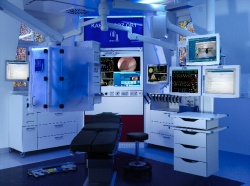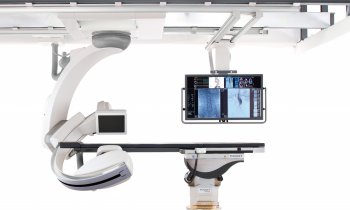Leipzig´s futuristic operating theatre
The next generation of integrated operating systems celebrated a world premiere in clinical use this November in Leipzig Germany. EH Correspondent Holger Zorn was there when Professor Gero Strauss entered the Surgical Deck of the International Reference and Development Centre for Surgical Technology (IRDC) as ´Commander`.


Dr Leonard Horatio McCoy, chief medical officer aboard the Starship Enterprise, was dismayed when he glimpsed medicine in the 20th century during the 4th Star Trek Movie: ‘This looks like the Dark Ages,’ he shouted. Today, if he returns to Earth and visits Leipzig he will undoubtedly change his tune. ‘The surgeon’s modern workplace is increasingly reminiscent of the cockpit in a passenger plane, with the surgeon acting as First Officer,’ explains consultant surgeon Professor Gero Strauss, Director of the IRDC and Head of Development at the Innovation Centre Computer Assisted Surgery (ICCAS) at the Medical Faculty of the University of Leipzig, and an ear, nose and throat consultant at Leipzig University Hospital.
Nine displays on the Surgeon’s Command Post, the Surgical Deck, ensure that all necessary information is available. A look into the human body goes beyond HD quality. With highly precise navigation technology and automatic warning systems in the background, the surgeon navigates more precisely and safely than ever before through sensitive tissue, past blood vessels and nerves. Perfectly implemented information systems display details such as vital signs and images about the internal patient in real time. Electronic patient files or 3-D CT and MRI images are available on demand. Up to 40 data sources are available during just a routine operation. The surgeon is also networked with the outside world and can consult external experts.
Optimised safety
In the Leipzig operating theatre the cables are shorter because medical devices hover over the patient, reducing drag and shear stress on sensitive instruments. ‘The IRDC is refining a unique specialist surgical concept. Architecture and ergonomics were adapted to the workflow of the surgical teams and thereby completely reorganised,’ Prof. Strauss points out. Coordinated technology lifts staff pressure and reduces routine tasks, enabling more reliable surgical work, reducing errors and ensuring the theatre is utilised more effectively.
The division into two separate, well-defined work areas for anaesthesia and surgical teams has also created a clearer work layout. Two emergency boxes in the cockpit, opened at the touch of a button, contain all emergency instruments and drugs.
Surgeonic
The new software Surgeonic tackles the patient’s digital data and surgical progress. It also makes intelligent connections, including automatic warning and collision avoidance. If need be, the navigation and monitoring technology of the world’s first Surgical Management and Guidance System can support a surgeon like an autopilot, assisting during particularly lengthy interventions and raising the alarm if previously determined limits are exceeded and a situation becomes critical, with the data appearing on the cockpit navigation panel, and as a flash in the microscope as well as presenting as audio signals or verbal warnings.
The system can suggest surgical steps or alternative routes. Special programmes and a digital scalpel facilitate even the tightest access for instruments and the steepest angles and filter out undesired movements. ‘The navigation components are adapted seamlessly,’ says chief engineer of the Surgical Deck, Professor Tim C Lüth, Chair of Micro Technology and Medical Device Technology at Munich’s Technical University. ‘The complex technical details and numerous new functions are integrated in a clearly IRDC’s advanced operating theatre laid out way and easily operated.’
The future operating theatre is a joint project of Leipzig and Munich universities and medical device manufacturer Karl Storz supplying the core Karl Storz Surgical Cockpit (KSSC) in the integrated operating theatre ‘OR1’. Dräger Medical supplies workspaces for the surgical and anaesthesia cockpit. Trumpf Medical Systems supplies patient positioning systems and links them with the OR1 and the KSSC. Carl Zeiss Meditec provides the surgical microscope OPMI Vario S81. The patient information system from Siemens Enterprise Communication offers all possible features of patient comfort, right down to the provision of excerpts from the patient file and an input medium for the surgeon. The KLS Martin Group is jointly developing new lighting concepts and their integration into the assistance systems and ergonomics of the surgical cockpit.To increase safety, surgical quality and ergonomics for the surgeon, Ergosurg and Karl Storz are working on mechatronic assistance systems.
The IRDC was among 365 winners of a Selected Landmark 2011 prize, an annual award in the initiative ‘Germany – Land of Ideas’ (Patron: The Federal President partnered by Deutsche Bank). ‘The creation of the operating theatre of the next but one generation furthers research into new technologies,’ said Michael Erfurt of Deutsche Bank. ‘The IRDC has created a unique project, which serves as a worldwide example.’
At Leipzig, Leonard McCoy would certainly not have to wait until 2264 to develop his neurosurgical techniques
20.12.2011











